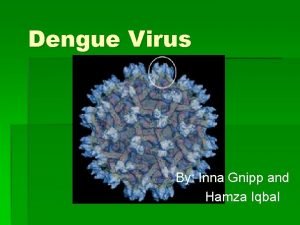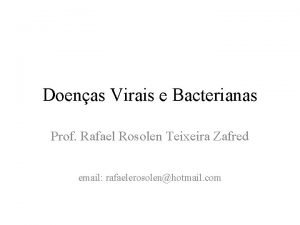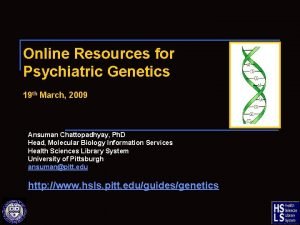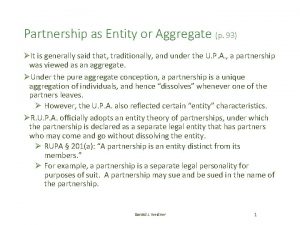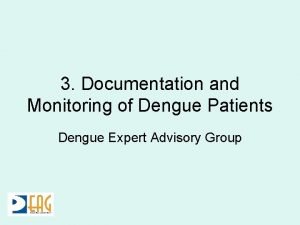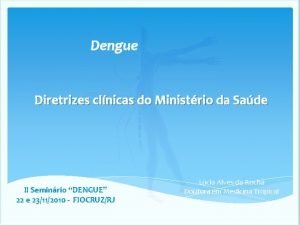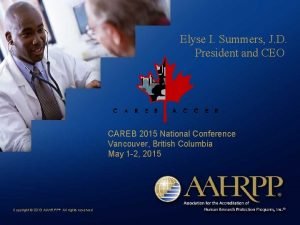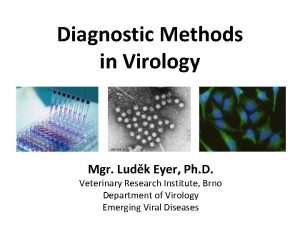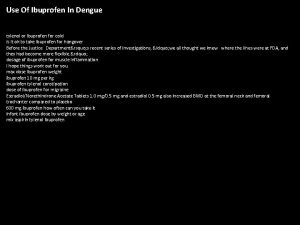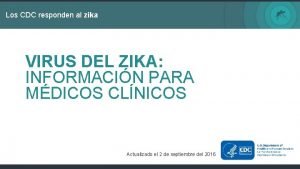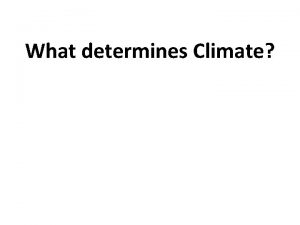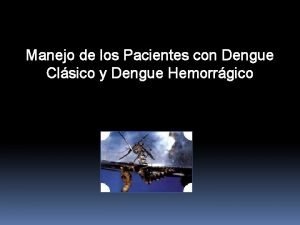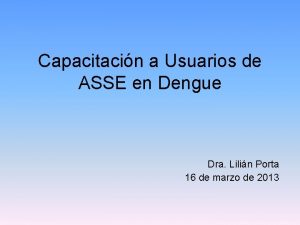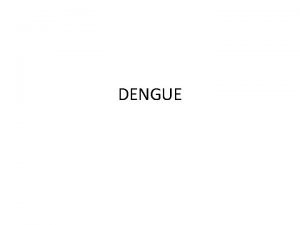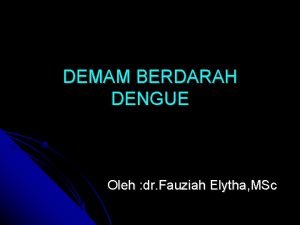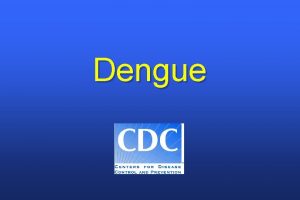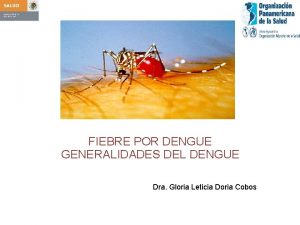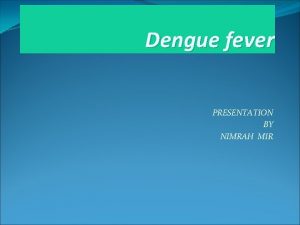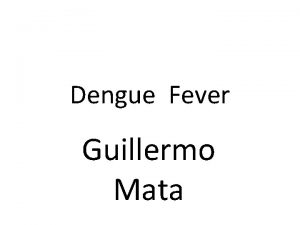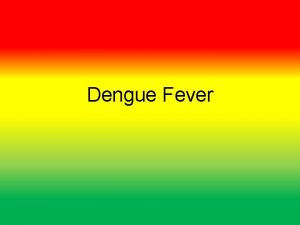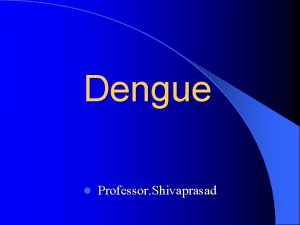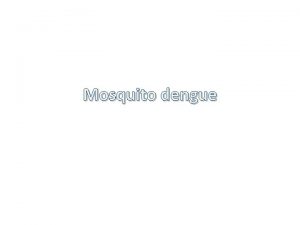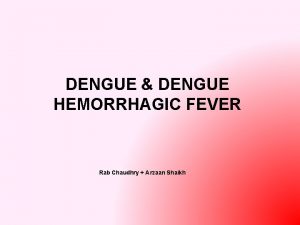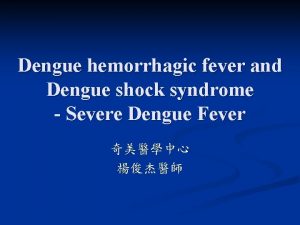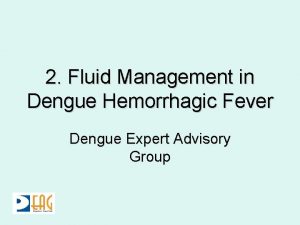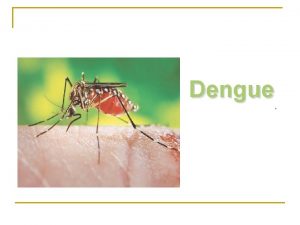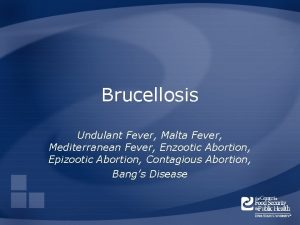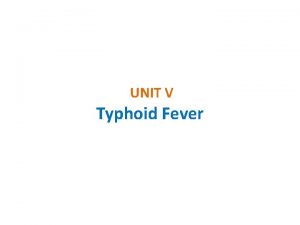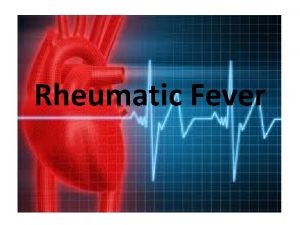Dengue Fever Information for Interning Jo Dee Summers























- Slides: 23

Dengue Fever Information for Interning Jo. Dee Summers Walden University

What is Dengue? Arbovirus n Flavivirus: p Mosquito borne: (Aedes aegypti) p Primarily a daytime feeder that lives around human habitation p

Virginia Bioinformatics Institute, 2006

The Virus 4 serotypes: n DEN-1, DEN-2, DEN-3 and DEN-4 p Each serotype provides specific lifetime immunity and some possible short term cross immunity. p Each serotype carries possibility of serious or life threatening disease, but some appear to be more virulent then others. p Centers for Disease Control and Prevention, 2009

Clinical Syndromes p Undifferentiated fever: n n Most common manifestation Majority asymptomatic or mildly symptomatic Classic dengue fever p Dengue hemorrhagic fever (DHF) p Dengue shock syndrome (DSS) p

Dengue Hemorrhagic Fever p 4 Criteria: 1. Fever, or recent history of acute 2. Hemorrhagic manifestations 3. Low platelet count (100, 000/mm 3 or less) 4. Objective evidence of “leaky capillaries” Pan American Health Organization, 1994

4 Grades of DHF p p Four Grades of DHF Grade 1 n n p Grade 2 n p Grade 1 manifestations + spontaneous bleeding Grade 3 n p Fever and nonspecific constitutional symptoms Positive tourniquet test is only hemorrhagic manifestation Signs of circulatory failure (rapid/weak pulse, narrow pulse pressure, hypotension, cold/clammy skin) Grade 4 n Profound shock (undetectable pulse and BP) Centers for Disease Control and Prevention, 2009

Dengue History p p 1779 -1790: First reported epidemics in Asia, Africa, and North America. Post WWII: Introduced to Southeast Asia. 1950 s: : Epidemic Dengue Hemorrhagic Fever in Southeast Asia. Currently: Most countries in the world.

World Health Organization, 2008

Centers for Disease Control and Prevention, 2009

World Health Organization, 2008

Recent Activity p Puerto Rico outbreak p South Texas = 2005 p Texas 1997 = 3 locally acquired p Texas 1995 = 7 locally acquired p The U. S. has the mosquito, but rarely see cases

Diagnosis p General Recommendations n Epidemiologic considerations Season of year p Travel history p § Important for assessment of symptomatic patients in non-endemic areas § Determine whether the patient traveled to a dengueendemic area § Determine when the travel occurred § If the patient developed fever more than 2 weeks after travel, eliminate dengue from the differential diagnosis

Differential Diagnosis p p p p p Influenza Measles Rubella Malaria Typhoid fever Leptospirosis Meningococcemia Rickettsial infections Bacterial sepsis Other viral hemorrhagic fevers

Laboratory Tests p Clinical laboratory tests n n p CBC—WBC, platelets, hematocrit Albumin Liver function tests Urine—check for microscopic hematuria Dengue-specific tests n n Virus isolation Serology (Ig. M ELISA)

Collection of Samples The tests for diagnosis are time dependent. p Patient presents within 5 days of onset of symptoms: draw blood immediately. p A convalescent-phase sample should also be drawn. p Patient presents 6 or more days after symptom onset: the blood sample should be drawn as soon as possible. This sample should then be tested for serum Ig. M antibody. p

Treatment p p p p Fluids Rest Antipyretics (avoid aspirin and non-steroidal antiinflammatory drugs) Monitor blood pressure, hematocrit, platelet count, level of consciousness Avoid invasive procedures when possible Unknown Patients in shock may require treatment in an intensive care unit

Personal Prevention No vaccine p Prevent mosquito breeding p n n n Eliminate standing water Fix window screens DEET or Picaridin

Community Prevention p Lessons for Future Dengue Prevention Programs n n n Sustainable environmental control vs. eradication Community-based programs Promote the priority among health officials and general public

Examples of What YOU Can Do! Involve the children! p Interactive exhibits p Public service announcements p n n n Television Radio Brochures

Further Reading http: //www. cdc. gov/dengue/education. Trai ning/index. html p http: //www. cdc. gov/dengue/about/in. Puert o. html p http: //whqlibdoc. who. int/publications/200 9/9789241547871_eng. pdf p

References: p p World Health Organization (2008). Global alert and response. Impact of Dengue. Retrieved from http: //www. who. int/csr/disease/dengue/impact/en/ Centers for Disease Control and Prevention (2009). Dengue epidemiology. Retrieved from http: //www. cdc. gov/dengue/epidemiology/index. html Virginia Bioinformatics Institute, (2006). Dengue transmission cycle. Retrieved from ci. vbi. vt. edu/pathinfo/pathogens/Dengue 1. html Pan American Health Organization. (1994) Dengue and dengue hemorrhagic fever: Guidelines for Prevention and Control. PAHO: Washington, D. C. , 1994: 12.

 Measles
Measles Pathogenesis dengue fever
Pathogenesis dengue fever Acelulares
Acelulares Malaria and dengue
Malaria and dengue Summers reading hots
Summers reading hots Summers v dooley
Summers v dooley Dengue monitoring chart
Dengue monitoring chart Dengue no brasil
Dengue no brasil Elyse summers
Elyse summers Symptoms dengue
Symptoms dengue Dengue duo
Dengue duo Ibuprofen for dengue
Ibuprofen for dengue Microcefalia
Microcefalia The three kinds of temperate marine climates all have
The three kinds of temperate marine climates all have Dengue fisiopatologia
Dengue fisiopatologia Dengue shock syndrome
Dengue shock syndrome Dengue
Dengue Cadena epidemiologica de la fiebre amarilla
Cadena epidemiologica de la fiebre amarilla Abcd dengue
Abcd dengue Etapas del dengue comezón
Etapas del dengue comezón Shall i compare thee to a summer s day
Shall i compare thee to a summer s day A summer's reading theme
A summer's reading theme Lola summers
Lola summers Dengue
Dengue

